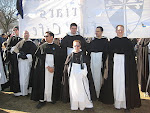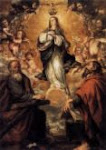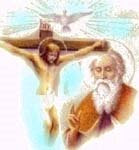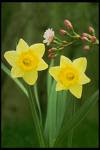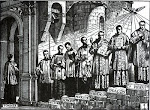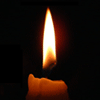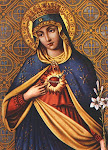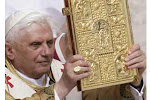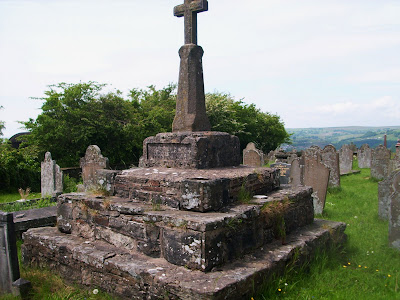






We set off
We set off at nine in the morning and drove down the m50 towards Abergavenny. The sun streamed down and the trees on wither side of the motorway were fully green with allsorts of blossoms. We reached Abergavenny Priory by eleven and had a cup of tea in the Angel.We picked up our son at the station and then set of down the Heads of the Valleys Road towards Merthyr. At the turn off to Aberdare, we started off steeply up the mountain road and very quickly were right at the top of the mountains, going around very tight bends.There is something very exhilarating about being on top of a mountain-it is like being on top of the world!
Arrival at Penrhys
Eventually reached the very top, when we got to Penrhys we took our seats. We were quite early so we did have a picnic and then got ready for the afternoon. And what a wonderful afternoon it was. Residents of Penrhys put up several large marquees and sold various things to offset costs. There was tea, there were cakes and sandwiches for tea afterwards. The Intention of the Pilgrimage
To ask Our Lady of Penrhys for the return home of fallen away and lapsed Catholics.As the pilgrimage has been renewed, so may the faith of all her children to ome Home.
The Joyful Mysteries of the Rosary
Laurence O’Leary was the organiser. Speaking to him afterwards, it seemed he was asked by the Holy Virgin whilst on pilgrimage to Medugorje to reinstate the pilgrimage to Penrhys, so that pilgrims return and give her honour.He introduced Theresa and all the pilgrims-about 500 recited the Joyful Mysteries of the Rosary. I have to say it was a rare treat. As the afternoon wore on , the voices echoed around the valley and as Laurence asked-‘Did you see all the angels around her?’ The atmosphere was so silent you could hear a pin drop. The silence and concentration of the Faithful was really charged with prayer.
A Prayer to the Holy and Undivided Trinity for the Consecration of Wales
A Prayer for the Consecration of Wales to the Immaculate Heart of Mary at Penrhys was recited by all present and addressed to the most Holy and Blessed Trinity. Most Holy Trinity,Our Father in Heaven, who chose Mary as the fairest of your daughters , Holy Spirit who chose Mary as your Spouse,God the Son who chose Mary as your Mother, in union with Mary, we adore your majesty and acknowledge your supreme, eternal authority. Most Holy Trinity, we place Wales in the hands of the Immaculate Heart of Mary in order that she present our country of Wales to you. Through her, we wish to thank you for our faith in this land, through the intercession of Mary, grant us peace in our families and peace in the world. Protect the family life of the nation. Guard the precious gift of religious vocations and protect our priests through the intercession of our Mother. Have mercy on the unborn, sick, elderly and disabled, the poor, the tempted, upon sinners, and all who are in need. Mary, Immaculate Virgin, our Mother, Our Lady of Penrhys , we invoke you and give you our country and ourselves to your Immaculate Heart.
The Procession
Some of the pictures above show the lines forming to walk up the mountain to form the Blessed Sacrament Procession. They are not empty seats! There were none! The Procession came down the Hill from the building of the Arts Centre to the singing of Faith of Our Fathers.
Faith of our fathers, living still,
In spite of dungeon fire and sword
O how our hearts beat high with joy!
Whene’er we hear that glorious Word!
Faith of Our Fathers! Holy Faith!
We will be true to thee till death!
The canopy was held over Bishop Daniel and the priests as they arrived proceeded by deacons and altar servers and knelt before the statue, and table which was dripping with flowers and candlesticks and candles and in the centre the Monstrance containing the Body of Our Lord Jesus Christ.The Faithful sang the O Salutaris and Tantum Ergo. There followed the Litany of the Blessed Virgin Mary and the Holy Name.
The Homily
(Catch it on P The Homily by Bishop Daniel concerned the Faith and the responsibility of all to evangelise fearlessly and openly and witness to the faith. It was moving and the whole homily can be heard on the Podcast of the Pilgrimage of Our Lady of Penrhys.If you have not got iTunes you can click on the link in the blog.Otherwise just type maryinmonmouth into the iTunes store window and it will come into your computer. There followed the prayer of St Michael, Archangel for Wales and this prayer:
Almighty God Who in Thine infinite goodness Has sent Thine only begotten Son into the world To open once more the gates of heaven And to teach us how to know, love and serve thee Have mercy upon Thy people who live in Wales. Grant to them the precious gift of Faith And unite them in the one true Church Founded by Thine own dear Son, that, Acknowledging her authority and obeying her voice They may serve Thee, love Thee and worship Thee As Thou desirest in this world And obtain for themselves Everlasting happiness In the world to come Through the same Christ our Lord. Amen
Bishop:Our Lady, help of Christians
Faithful:Pray for us
Bishop:St David
Faithful:Pray for us
Bishop:St Winefride
Faithful:Pray for us.
The long Recessional Hymn was the
Our Lady of Penrhys Hymn Tune:Lourdes
 ________________________________________________ Here are some of the verses….
________________________________________________ Here are some of the verses….
1.All glory to God for this wonderful place Which stands as a witness of mercy and Grace Ave, Ave, Ave Maria
2.For here in the Rhondda,here stands the blest shrine Which tells us of Jesus, the gift most divine.Ave..
3.For here in the valley a statue once stood Of Mary and Jesus concealed in a wood.Ave
4.And here with the monks they illumined the shrine In honour of Jesus the Saviour divine.Ave….
5.With candles and flowers the people would come To honour Our Lady and her greater Son Ave
6.And people would gather to see Christ displayed In the arms of his Mother in glory arrayed. Ave
7.With love and affection held close to her breast A kiss for her Saviour, she rocked him to rest. Ave..
8.And there as a gift for the suppliants sweet A spring of clear water flowed forth near her feet. Ave
9.And pilgrims who drank from the water were healed As Christ’s sovereign power was revealed Ave…
10.From Gwynedd and Powys, from Dyfed and Gwent The pilgrims would come and requests would be sent Ave….
11.And signs of God’s mercy and healings bestowed Were witnessed by those on the pilgrimage road Ave..
12.But then came a new king and sadly twas learned The statue was taken to England and burned Ave..
13.And here where the honour of Jesus was kept The people of Wales now with misery wept. Ave…
14.And ruin and darkness came over the place And of Mair on Penrhys with longing to pray Ave..
15.And there on the mountain with water still flowed A witness to all of the blessings of God Ave….
16.The centuries turned and the water flowed on With a message of hope until Wales was reborn Ave….
To God the All Sovereign, and Son, with due praise And Spirit of Holiness ,worship we raise. Ave…


 _________________________________________________________________
_________________________________________________________________
Scallops, staffs, books and Rosaries
On sale at the shrine were rosaries made by the ‘Crafty Pilgrims’ there were beautiful scallop shells, and pilgrims staffs .
Water Wood and Fire
The book has the Penrhys tour as its theme, and water being the Holy Well, the Wood being the oak tree in which the carving of the Holy Virgin appeared to have been carved, and fire when it was dragged at midnight to London and burnt. The book has been written and produced by children from the local schools. (Dwr, coed a Thân )The art and the poetry is very moving.My favourite is a poem by Liam Brabon and concerns the symbol of the scallop shell-the St James of Compostella pilgrims’ shell, now universally accepted as an emblem for a pilgrim.
http:/www.penrhys.com, email: penrhys@penrhyspartnership.co.uk 01443 755008 <
A href="https://blogger.googleusercontent.com/img/b/R29vZ2xl/AVvXsEgnlp2jZHXexdFrAFDz3StdTqL3VEOOpxXB7sN7LJJMnInYWLHpG7euASfuB2jABUSLptKIbLy038FCdZiTYIUTjnxSzoW1a9n1gb-alo3ghzf2MSHSanm1d-uN7F_BRo_XW-AQ5C7Dtp7w/s1600-h/Our+Lady+of+Penrhys+2008+038.JPG">



If you would like a copy of ‘Water wood and Fire’. 18 of the poems are in Welsh, and about 28 in English. All the money raised from the book goes to improve local facilities for the pilgrims and improve the local area so that the pilgrimage can grow. At the end of the final hymns, small children were commissioned by elderly people to clamber down to the well and fill plastic bottles with the holy water from the well. They enthusiastically scuttled up and down the bank with the plastic bottles. There is a good size car park right next to the pilgrimage site.Penrhys is reached from Ferndale.
Prayer for Priests
Please pray for a priest for the people of Ferndale and Penrhys. Somewhere out there is a priest who will come to look after the church and pilgrimage. Please pray for someone to come and provide a local priest. Hope you enjoy the pictures. My podcast has some great interviews with the pilgrims and the pilgrimage leader Laurence O’Leary.
The Welsh Parishes Pilgrimage will be repeated next year on the last Sunday in May 09




